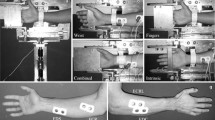Abstract
Upper extremity muscle injuries from rock climbing are common. Knowledge of the activity of specific muscles during climbing may allow the development of training programs to reduce these injuries. This study evaluated the electrical activity of the first interosseous (IN), brachioradialis (BR), flexor digitorum superficialis (FD), and biceps brachii (BB) muscles in seven climbers by integrated electromyography (IEMG) during finger-tip pull-ups. The climbers, with forearms pronated, performed three consccutive pull-ups. Each pull-up consisted of: (1) hanging using four fingers of each hand, (2) pullup to maximum elbow flexion, (3) slow return to starting position. The IEMG during maximum voluntary contraction (MVC) was obtained for each muscle separately, and the IEMG was normalized to MVC. During hanging, FD showed the highest normalized IEMG (0.64±0.20). During pull-up, the highest IEMG was produced by FD (0.69 ±0.25) and BR (0.67±0.19), while BB showed only 0.33 ±0.12 and IN 0.09±0.06. During lowering, FD again had the highest IEMG (0.74±0.24), while the EMG from BR was decreased to 0.42±0.14 and BB to 0.15±0.15. BR and BB showed an abrupt peak in EMG during pull-up and lowering, as opposed to FD which remained constantly highly activated, which suggests that FD does not contribute to elbow flexion even though it crosses the elbow joint. The high activation of FD and BR may explain their elevated incidence of injury during climbing. Thus, a reduction in climbing-related muscle injuries may be achieved by a training program that emphasizes conditioning of the BR and FD muscles.
Similar content being viewed by others
References
Basmajian JV, Latif MA (1957) Integrated actions and functions of the chief flexors of the elbow. J Bone Joint Surg [Am] 39: 1106–1118
Bollen SR (1988) Soft tissue injury in extreme rock climbers. Br J Sports Med 22:145
Bollen SR (1990) Upper limb injuries in elite rock climbers. J R Coll Surg Edinb 35 (Suppl):18
Kapandji IA (1987) Flexor muscles of the elbow. In: Kapandji IA (ed) The physiology of joints. Churchill Livingstone, p 92
Robinson M (1993) Climbing injuries to fingers and forearms. Climbing 138:141–150
Shea KG, Shea OF, Meals RA (1992) Manual demands and consequences of rock climbing. J Hand Surg [Am] 17:200–205
Taxx AAM, Denier van der God JJ, Erkelens CJ (1990) Differences in coordination of elbow flexors muscles in force tasks and in movement tasks. Exp Brain Res 81:567–572
Thepaut-Mathieu C, Maton B (1985) The flexor function of the pronator teres in man: a quantitative electromyographic study. Eur J Appl Phys 54:116–121
Zuniga EN, Simons DG (1969) Nonlinear relationship between averaged electromyogram potential and muscle tension in normal subjects. Arch Phys Med Rehab 50:613–620
Author information
Authors and Affiliations
Rights and permissions
About this article
Cite this article
Koukoubis, T.D., Cooper, L.W., Glisson, R.R. et al. An electromyographic study of arm muscles during climbing. Knee Surg, Sports traumatol, Arthroscopy 3, 121–124 (1995). https://doi.org/10.1007/BF01552388
Issue Date:
DOI: https://doi.org/10.1007/BF01552388




